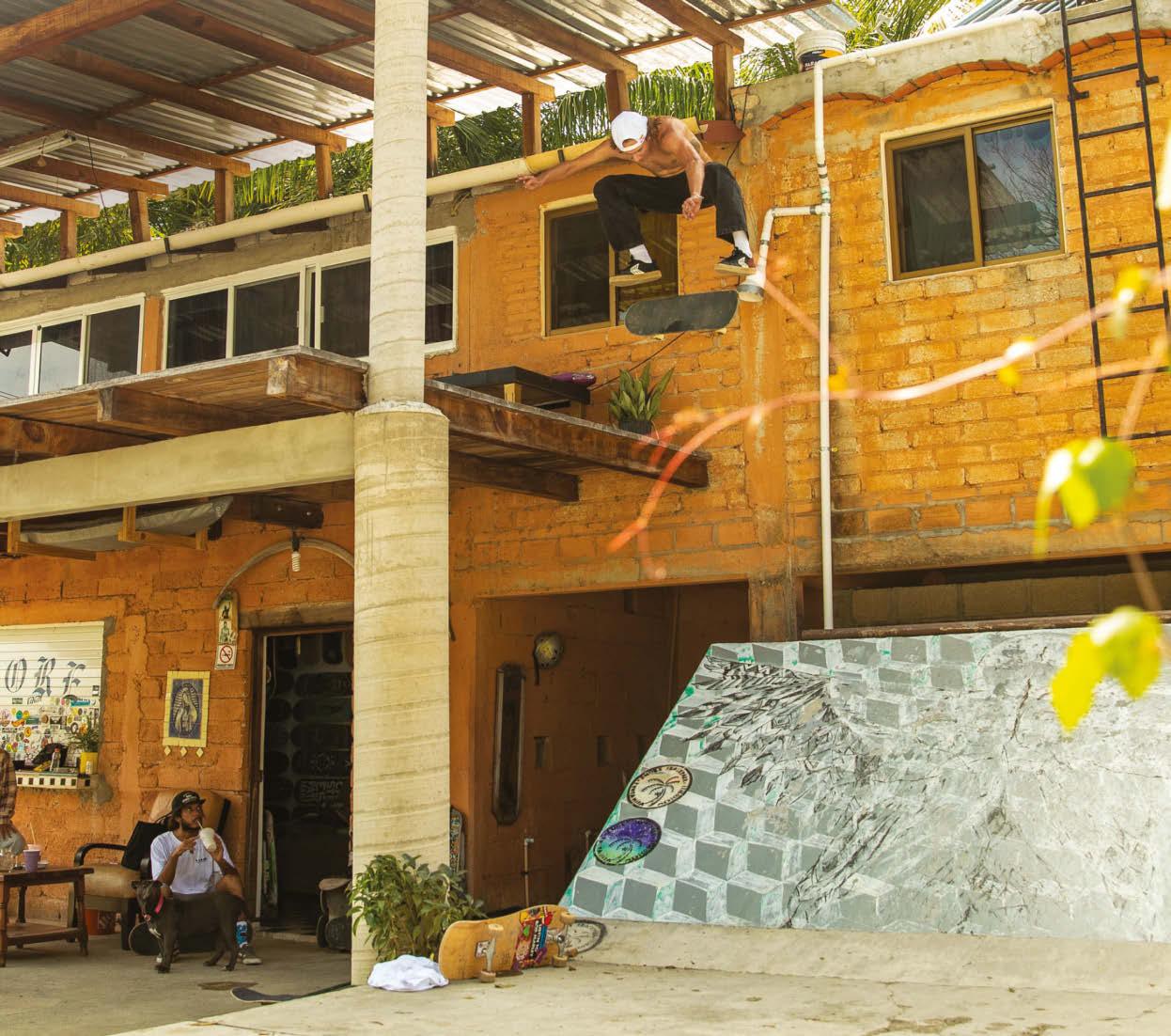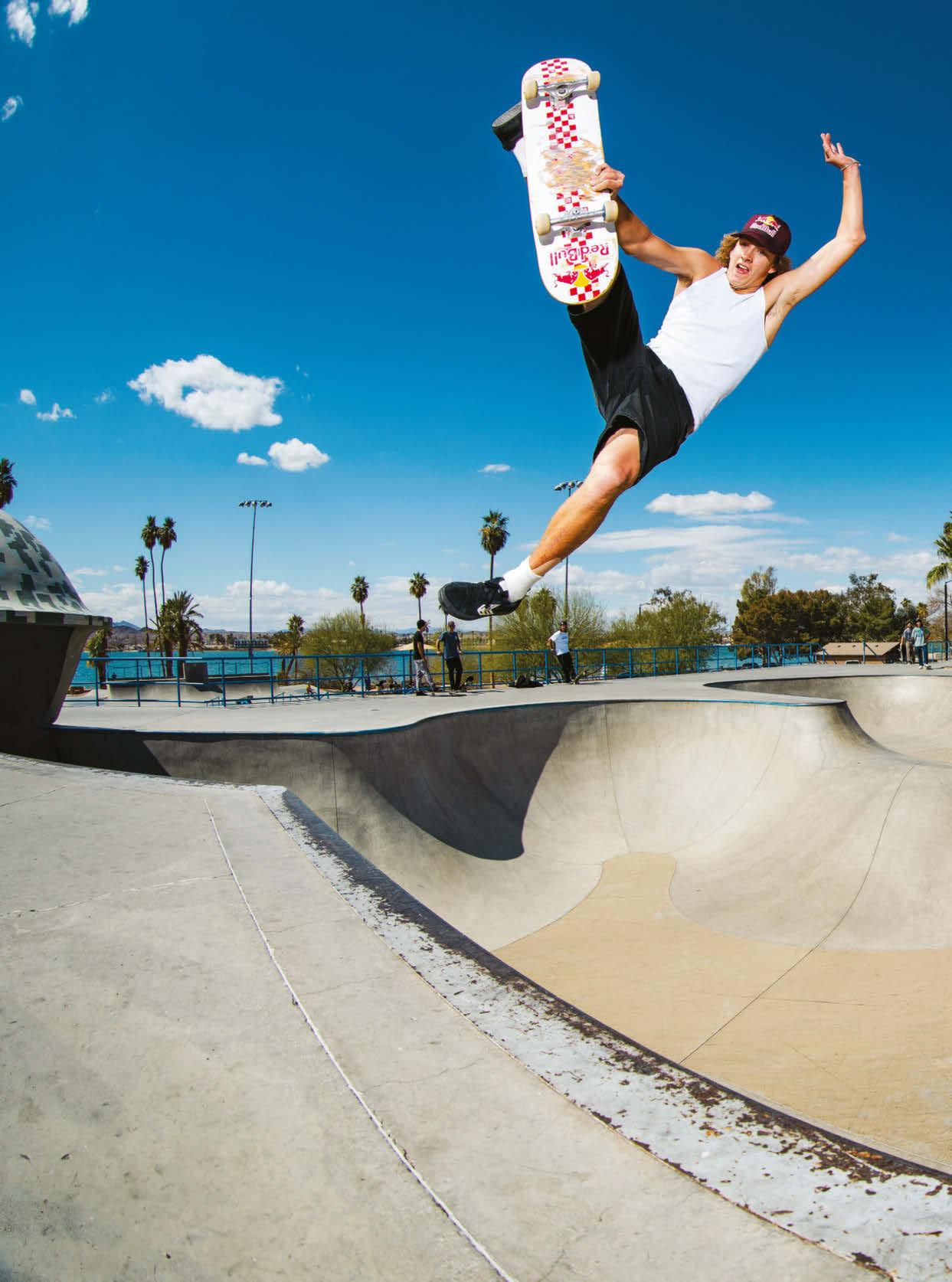
14 minute read
Flight Plan
There’s only one skater on Earth who has a legitimate shot to win both the street and park disciplines in his Tokyo debut. His name is Jagger Eaton.

“I love competing,” says Jagger, who was photographed in Lake Havasu City, Arizona, on March 10.
Jagger has been skating his entire life, but his evolution as an athlete and an individual has picked up speed in recent years.

JAGGER EATON WAS BORN INTO COMPETITION.
As the son of gymnasts who competed and then coached at the Olympic level, his earliest memories are training in his family’s gym, KTR (short for Kids That Rip), near Mesa, Arizona. As Jagger recalls, his father told him on Christmas Day at age 4 that he didn’t look good in a leotard, so they put a skateboard under his feet instead. Currently 20 years old, Jagger grew up at a time in which the Olympics always seemed like a possibility for him, something his parents always talked about. “My dad only knew competition, so that’s what we did. We skated to compete.”
The kid from Mesa is now training for skateboarding’s birth as an Olympic sport and is the only skater who might compete in both disciplines—street and park, but more on that later—in Tokyo. A lot’s happened in the last 12 months for Jagger: Though there have been no contests, he got himself a solid board sponsor (The Heart Supply); he put out a respected street video part; and he turned pro. Now, even as he is looking down the barrel of Tokyo, amid his highly structured training regimen, he’s still bagging street clips with friends on the weekends. That competitive DNA never rests.

On an overcast day in April in Vista, California, we’re at the CA Training Facility, a high-performance skate center in northern San Diego County where Jagger trains three days a week. It’s a Thursday, so Jagger is focusing on his tricks on the big rail (eight stairs). He wants to land each trick five times in a row before he moves on to the next one. He’s doing über-technical stuff like backside 180 kickflip nosegrinds—tricks that’ll score a 9 out of 10 with the judges. It’s similar to the gymnast regimen he grew up with. Jagger’s rocking a sleeveless Harley Davidson T-shirt as hip-hop from his iPhone blares through a speaker. He’s doing these drills by himself, which is worth noting, as most top skaters prefer a friend to skate with them when they’re trying something gnarly. He lands his tricks and the rail training ends as quickly as it began. Jagger grabs his iPhone and his helmet and heads upstairs to the park bowl, where a heated session is already underway with fellow pros Jordyn Barratt and Beaver Fleming.
Jagger rolls into the bowl with speed and flawlessly nails a run full of huge ollies, long noisy Smith grinds and stand-up 50-50s. This is just a warm-up run, but it’s obvious that he’s head and shoulders better than the other skaters working on their runs this day. Jagger’s good friend Heimana Reynolds, who’s sitting at No. 1 with the most Olympic qualifying points in park at the moment, joins the session. “With the amount of board control he has, you can tell he’s skated every day since he was young,” Reynolds says. “And I know how hard he worked when he was young.”
Later, hanging in the back parking lot, Jagger notes the positives of skating with other pros in California.“I appreciate being able to skate a facility like this, and be
Once he discovered the raw soul of street skating, something clicked for Jagger. Here he is in Puerto Vallarta, Mexico.

Jagger has been skating religiously since he was 6, and his work ethic to master tricks is highly structured.

around someone like Heimana,” he says. “He’s the number one park skater in the world and one of my best friends, and we get to skate every day.”
The skatepark here in Vista mimics what Jagger will skate in Tokyo. It was constructed by California Skateparks, the same company that’s building the courses for the Games, so everything from the metal of the handrails to the steepness of the concrete transitions is similar to what competitors will see in Tokyo. There’s a street layout (with ledges, banks, handrails and quarterpipes) and a park course— basically a huge bowl with hips, bumps and varying deck heights. When the time comes, Jagger will have 45 seconds to put together a flawless run, mixing technical tricks with bigger stunts to get the best score possible from the judges.
The name Jagger conjures up pure rock ’n’ roll swagger, not necessarily a scrawny kid from the desert. His older brother Jett (yes, it’s a Joan Jett reference) came up at the same time as Jagger. As an added bonus, we’ll let you know that his other siblings’ names are Bowie, Hendrix and Koston (that last one is one of skateboarding’s GOATs).
“I don’t think my parents wanted any of us to be rock stars, they just love music,” says Jagger. “Their first date was at a Rolling Stones concert.” As a kid, Jagger tried his hand at the guitar, but he had already broken both elbows due to skating, so he couldn’t hold it properly. “My dad was always OK with the risk [of getting hurt], but my mom’s been through some stuff with us,” Jagger says. “Having eight broken bones before I was 13—my mom had to deal with that.”
But as the injuries piled up, so did the accolades. Jagger won Best Trick at the Kimberley Big Air down in South Africa in 2013. In 2014 he won the Tampa Am and in 2018 the Tampa Pro, the top grassroots proving-ground contests.
Despite his contest successes, Jagger had a rough time securing shoe and board sponsors in those years. Not every cool, top-tier board brand wants the contest kid if he’s not also showing and proving in the streets with video parts and photos in the mags. Plan B, Jagger’s board sponsor for many years, didn’t want to turn Jagger pro even though he was winning contests—and Jagger gets it. “It’s all love for Plan B and DC Shoes,” he says. “We were going on different paths. They weren’t really supporting what I was doing. I love competing, so if you don’t support that it’s kinda hard to be in my corner.”
Jagger’s been a household name on the contest circuit since he was a kid. “He was 9 years old or something and I was like, Oh my god, this kid is gnarly,” says Jagger’s private coach, Neal Mims. “He was already kickflipping into frontside boardslides and just doing really technical stuff at such an early age. He was one of the first kids I saw at that age who was innovating.” KTR was originally a gymnastics training facility, but when Jagger turned 6, and his older brother Jett was 8, their parents began building skate ramps in the gym. It essentially gave them a huge skatepark of their own. KTR began hosting skate contests as
well, so Jagger’s first taste of competition was in his own biodome. He attended school at KTR, too, so his whole life was within the walls of the family business.
Jagger’s dad kept him on a gymnasticsstyle training program, very regimented and structured, which left him pretty sheltered from the outside world. But the X Games were well established and on TV by this time, with Tony Hawk and Shaun White as household names. If your gifted young son is already doing the same vertical tricks these pros had become famous for, why wouldn’t you push him into contests?
Then at age 15, a pivotal direction change happened: Jagger discovered skateboarding’s original soul, its outlaw fringe—street skating. The sheltered existence he had known as a child crumbled. He took to the streets like a duck to water and started piecing together the opus that every street skater wants—the one thing that defines you and will be watched and remembered: a video part.
A video part is a three-to-five-minute edited piece of your best moments, set to (hopefully) a great song that will stand up over time. It can take several years to collect the footage for these few minutes. Trips around the world, months off the board due to injuries, multiple missions back to one skate spot due to security, weather and parked cars—all just to get one trick. But that’s why they’re so important. And if a skater drops a part as solid as Jagger’s Heart Supply pro part, it can change everyone’s perception of that skater and really get the ball rolling with their career and sponsors. This was different from his contest placing. Among his peers and the industry, he suddenly earned a new sense of respect.
Neal Mims is more than a private skate coach. A former pro skater, Mims has been working with Jagger for two years. Mims was familiar with Jagger’s upbringing and how it affected him. “He didn’t have much of a normal childhood and missed out on just going outside and hanging with your friends,” Mims says. “KTR created this incredible skateboarder, but there may be parts of his childhood that he’s missing.”
The love goes both ways. “To call him a coach is an understatement,” says Jagger. “He’s a really good life mentor. Having him help me with strategy is a huge help. Athletes at my level don’t really need help doing stuff, we need to be told when to stop. He gives me that extra confidence boost before a contest, like, ‘Hey you don’t need to do anymore reps, you’re ready.’”
For many years Jagger’s dad had been the one pushing him, but the new dynamic with Mims seems to be working. Mims had been a judge for a lot of the big contests, during which Jagger’s dad would often ask for advice about what the judges were looking for. Judging skateboarding contests is seasonal and sparse at best, so Mims saw an opportunity with the Eaton family. “Why don’t I stop judging and just work with Jagger?” he asked himself. “I’ll be a mentor to him. I’ll help him with his mindset and his attitude toward skateboarding.”
Jagger is in the delicate phase of really becoming his own person, and Mims has a front-row seat to watch it unfold. “What I’ve seen is a lot of growth in a short amount of time,” Mims says.
Many people knew Jagger best for his role in a breakout TV show. After his wins in South Africa and Tampa in 2013 and 2014, he inked a deal with Nickelodeon.

Jagger’s soulful street style is on display with this kickflip backside lipslide at a school in San Diego.

Jagger’s ambitions hardly end with Tokyo; his potential to innovate in both skate disciplines could take a decade to unfold.

Jagger Eaton’s Mega Life ran from 2016 to 2017 and cast a global spotlight on the kid who’d grown up in an Arizona skatepark. The show aimed to push Jagger out of his comfort zone and had him swimming with sharks, heli-boarding and doing other hairball activities. “It was really cool and I had a great time doing it. It’s all love to Nickelodeon. People bring it up all the time and you can still buy both seasons on Apple TV! It was a really cool time in my life and I hope I changed some lives through it.”
But that’s the past now. Jagger was able to film his pro part during the pandemic and has shattered the old identity as the kid with the Nickelodeon show. “He’s really a big-hearted young man now,” says Mims. “He cares about how he’s perceived and he’s doing a lot better being positive in front of crowds.” Jagger had been known in the past to be a bit bratty and lose his temper at contests. It’s another reason why his Heart Supply part is so important, to show the world he’s grown into a new, better person.
In 2020, Jagger finally found a boardsponsor home in Johnny Schillereff’s Heart Supply, an offshoot of his popular Element brand focused on giving back to the skate community. And in a familyaffair vibe, Jagger’s younger brother Koston and Johnny’s son Camp ride for the brand as well. In November 2020, Jagger’s debut pro part dropped and showed the skate world just how gnarly and legit he is in the streets—underscoring how he was considered “just a contest skater” no more. It highlighted how Jagger is finding himself as his career gels around him. He’s a really gnarly skateboarder and is finally finding the sponsors and tribe of people supporting exactly what he’s doing.
Skateboarding’s Olympic debut is at long last here, after a one-year postponement and a year without contests. There won’t be a live audience, but millions around the world will see what Jagger is made of. He’s the only skater poised to contest both disciplines that’ll be on display: street and park.
That’s insane. Team USA only has slots for three skaters in each discipline, and Jagger could possibly end up on both sides. Getting to skate in the actual events in Tokyo is a convoluted points system at best; Jagger has racked up points in both disciplines as of press time but isn’t a lock yet on either team. (See? Confusing!) USA Skateboarding would actually prefer it if Jagger just competes in one discipline.
Mims feels this is something that USA Skateboarding should be proud of and embrace. “He’s the only skateboarder on the planet that can do both at a high level,” Mims says. “That should be marketed and promoted—like this is USA, we’ve got one of the best! But they don’t see it that way.” And for Jagger, if people tell him he can’t do something, well, they just gave him the biggest reason to go for it. Currently he is on the park team, but Jagger, who was on the street team last year, is allowed to skate both disciplines at contests.
Jagger has the ability to pull it off, but it will require double the training and wear and tear on the body, “The thing about training for both disciplines is that no one’s in better shape than I am,” he says. No doubt, the guy’s got confidence and has been preparing for this scenario. Preparing for over 10 years, really.
“It’s hard as hell,” says Reynolds, appraising the difficulty of vying for spots on both teams. “If anybody’s gonna do it, Jagger’s the one.”
No matter how it shakes out, the competition will be intense. In street— the discipline Jagger says will be tougher for him—he’d go up against fellow American Nyjah Huston and Yuto Horigome of Japan. And in park he’d face American Cory Juneau as his biggest threat. The U.S. squad will have its roster cemented after the Dew Tour in May in Des Moines, Iowa, the final park Olympic qualifying event.
Briefly putting aside his outsized personal ambitions, the kid with the rock star name is confident that American skaters will come home with all the hardware. “USA is gonna put on,” Jagger says. “That’s what we’re going for.”
However things shake out in Tokyo, at 20 years young, Jagger is still in the early years of his career. He’s got a solid 10-year run ahead of him easy. The kid is training every day to be a super athlete so this won’t likely be the only Games he competes in, and he’ll be a force to be reckoned with at all the competitions in between. The Heart Supply and newcomer to the skate footwear scene Cariuma are solidly backing him so he’s got all the freedom in the world to skate how he wants. We’d all love to see another gnarly street part in the years to come, but regardless of that, we’re going to see one of the best young contest skaters evolve into a beast and become a household name. In a lot of ways, this is just the beginning.




